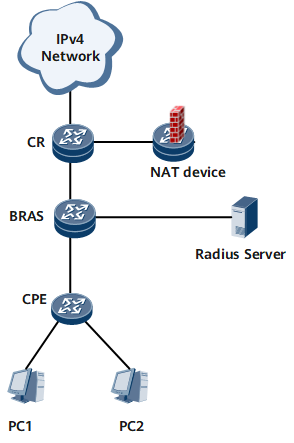Configuring a Static Source Tracing Algorithm
This section describes how to configure a static source tracing algorithm.
Usage Scenario
A static NAT source tracing algorithm is in essence a set of formula. The input is the private IP address range, public IP address range, port segment size, and port range. The output is the mapping between private IP addresses and public IP addresses/port range. When a device uses a static source tracing algorithm to implement NAT, the mapping between the private IP address range, public IP address range, and port range is fixed. In this case, NAT source tracing can be performed for NAT source tracing NEs, such as the AAA server, based on the algorithm so long as the source tracing algorithm parameters that are the same as those on the NAT device are obtained, instead of depending on the source tracing logs sent by NAT devices.
The static source tracing algorithm applies to centralized NAT. In the centralized NAT scenario, if the static source tracing algorithm is configured, load balancing can also be configured. Figure 1 shows network deployment for static source tracing in centralized deployment mode.
Pre-configuration Tasks
Before configuring a static NAT source tracing algorithm, complete the following tasks:
- Configure data link layer protocol parameters and IP addresses for interfaces so that the data link layer protocol on each interface can go Up.
- Configuring a Mapping Policy for a Static Source Tracing Algorithm
- With a mapping policy for a static source tracing algorithm, the mapping between the IP addresses in a private address pool, the IP addresses in a public address pool, and the port range can be manually specified.
- Applying a Static Source Tracing Algorithm to a NAT Instance
- This section describes how to apply a static source tracing algorithm to a NAT instance so that the mapping between the IP addresses in the private and public address pools is applied to the NAT instance.
- Verifying the Configuration of the Static Source Tracing Algorithm
- After configuring a static NAT source tracing algorithm, check the configurations.
